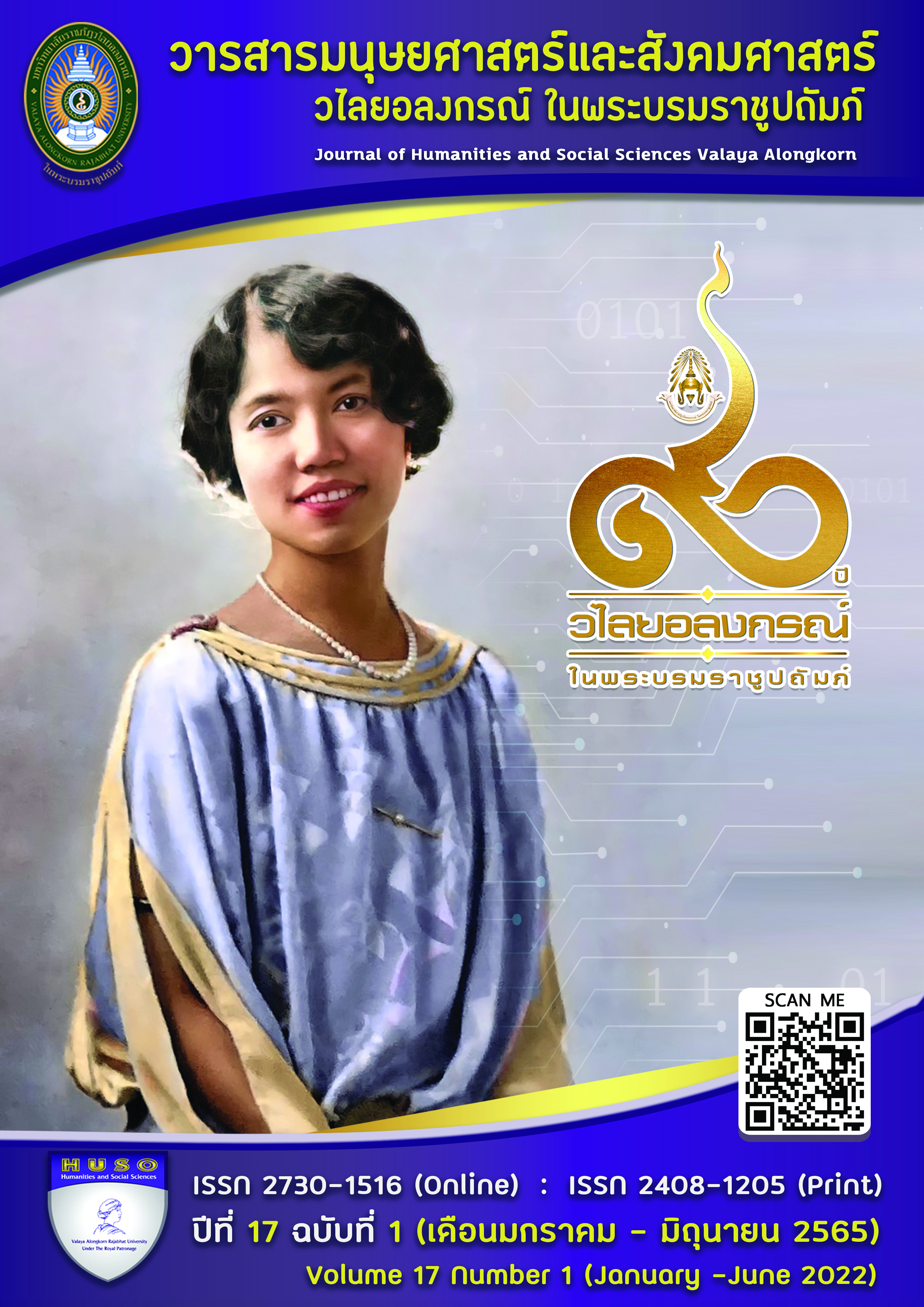KNOWLEDGE MANAGEMENT FOR PRESERVING MON CULTURAL IDENTITY: CASE STUDY OF RAM PHA KHAO SAN TRADITION, CHEDI THONG COMMUNITY, SAM KHOK DISTRICT, PATHUM THANI PROVINCE KNOWLEDGE MANAGEMENT FOR PRESERVING MON CULTURAL IDENTITY: CASE STUDY OF RAM PHA KHAO SAN TRADITION, CHEDI THONG COMMUNITY, SAM KHOK DISTRICT, PATHUM THANI PROVINCE
Main Article Content
Abstract
A study of knowledge management for preserving Mon cultural identity: Case Study of Ram Pha Khao San Tradition, Chedi Thong Community, Sam Khok District, Pathum Thani Province. The objectives of the study were to study knowledge management within Chedi Thong community, Sam Khok District, Pathum Thani Province for preserving and carry-on Ram Pha Khao San Tradition and to study the identity and the way to maintain Ram Pha Khao San Tradition of Thai Mon people in Pathum Thani Province. The sample population for this research were the community leader, philosopher. The data used by the researcher were divided into two types: the information from documents relating to the history of the Mon people and field data from interviews for the presentation of research results using descriptive methods.
The results of the study were as follows:
1) the researcher found that within Chedi Thong Community, Sam Khok District, Pathum Thani Province. There are people in the community who have applied some aspects of the knowledge management process to manage knowledge for youth or the people in the community, such as knowledge identification or identification of knowledge issues, patterns, people who were knowledgeable that corresponding to the policy, scope and goals of the community in preserving and carry-on Ram Pha Khao San Tradition, The researcher found that the agency and community had indicated knowledge through the activities of Ram Pha Khao San Tradition to people within the community in order to achieve the purpose of preserving and carry-on a unique culture. There was solidarity within the community in the topic 7 (Learning) which is knowledge sharing and learning. In this part of the community, teaching is organized through local philosopher to the community and through educational institutions such as Wat Chedi Thong Community School, Chaisitthawat School “Pat Saibamrung”, Pathum Thani University and Valaya Alongkorn Rajabhat University under the Royal Patronage
2) Mon culture preservation of Chedi Thong Community, Krachaeng Sub-district, Sam Khok District, Pathum Thani Province is a Mon community with characteristics suitable for community-based tourism. The condition generally had the way of life of the indigenous community inherited from the ancestors. There was preservation of culture, traditions, way of life, ancient sites and the antiques in today's changing society have changed the environment and occupation of the people within the community all the time.
Article Details

This work is licensed under a Creative Commons Attribution-NonCommercial-NoDerivatives 4.0 International License.
ลิขสิทธิ์บทความวิจัยที่ได้รับการตีพิมพ์เผยแพร่ในวารสารมนุษยศาสตร์และสังคมศาสตร์ วไลยอลงกรณ์ ในพระบรมราชูปถัมภ์ ถือเป็นกรรมสิทธิ์ของคณะมนุษยศาสตร์และสังคมศาสตร์ มหาวิทยาลัยราชภัฏวไลยอลงกรณ์ ในพระบรมราชูปถัมภ์ ห้ามนำข้อความทั้งหมดหรือบางส่วนไปพิมพ์ซ้ำ เว้นแต่จะได้รับอนุญาตจากมหาวิทยาลัยเป็นลายลักษณ์อักษร
ความรับผิดชอบ เนื้อหาต้นฉบับที่ปรากฏในวารสารมนุษยศาสตร์และสังคมศาสตร์ วไลยอลงกรณ์ ในพระบรมราชูปถัมภ์ เป็นความรับผิดชอบของผู้นิพนธ์บทความหรือผู้เขียนเอง ทั้งนี้ไม่รวมความผิดพลาดอันเกิดจากเทคนิคการพิมพ์
References
กชพร ตราโมท. (2541). มอญรำ (ปัวฮะเปิ้น): ศิลปะคุณภาพของมอญ. จุลสารไทยคดีศึกษา.
กรุงเทพฯ: สถาบันไทคดีศึกษา.
คณะวารสารศาสตร์และสื่อสารมวลชน มธ. (2555). การจัดการความรู้ในองค์กร. [ออนไลน์]. เข้าถึงได้จาก : http://203.131.210.100/km/?page_id=7 . (2564, มิถุนายน 22).
ชัยสิทธิ์ ด่านกิตติกุล. (2559). แนวทางการจัดการภูมิทัศน์วัฒนธรรม กรณีศึกษา: ชุมชนมอญสังขละบุรี
จังหวัดกาญจนบุรี. กรุงเทพฯ: มหาวิทยาลัยศิลปากร.
ดุสิตธร งามยิ่ง. (2559). รำมอญ: ประเพณีทรงคุณค่าจังหวัดปทุมธานี. วารสารวไลยอลงกรณ์ปริทัศน์.
(2): 57-66.
พัลลภ สุริยกุล ณ อยุธยา . (2542). เอกลักษณ์ทางวัฒนธรรมและการเปลี่ยนแปลงทาง วัฒนธรรม
ของชาวมอญ : ศึกษากรณีหมู่บ้านเจดีย์ทอง ตำบลคลองควาย อำเภอสามโคกจังหวัด ปทุมธานี. กรุงเทพฯ: จุฬาลงกรณ์มหาวิทยาลัย.
ณัฐประวีณ ศรีทรัพย์ . (2537). การเปลี่ยนแปลงทางสังคมและวัฒนธรรมและการธำรง เอกลักษณ์
ทางวัฒนธรรมของชาวมอญ.กรุงเทพมหานคร: ฐานข้อมูลวิทยานิพนธ์ไทย.
สราวุฒิ พันธุชงค์. (2562). แนวทางการจัดการความรู้ที่ได้มาตรฐานระดับสากล. (ออนไลน์). เข้าถึงได้จาก :
https://www.nstda.or.th/home/knowledge (2564, มิถุนายน 24).
สิทธิโชค วิบูลย์. (2554). การศึกษาการอนุรักษ์ทางวัฒนธรรมชาวมอญเพื่อการพัฒนาการท่องเที่ยวชุมชน กรณีศึกษา: ชุมชนศาลาแดงเหนือ จังหวดปทุมธานี. วารสารวิจัยและพัฒนา วไลยอลงกรณ์
ในพระบรมราชูปถัมภ์.
Dankittikul C. (2016). Cultural Landscape Management: A Case Study of Mon's Community
in Sangkhlaburi, Kanchanaburi. Bangkok: Silpakorn University. [in Thai]
Faculty of Journalism and Mass Communication, TU. (2012). Knowledge Management
in Organizations. [Online], Available: http://203.131.210.100/km/?page_id=7.
(2021, June 22). [in Thai]
Ngamying D. (2016). Mon Dance: The Value of Pathum Thani Province’s Tradition.
Valaya Alongkorn Review. 6 (2): 57-66. [in Thai]
Phantuchong S. (2019). Guidelines for Knowledge Management: International Standards. [Online], Available: https://www.nstda.or.th/home/knowledge (2021, June 24). [in Thai]
Srisap N. (1994). Socio-Cultural change and ethnic identity of the Mons. Bangkok: Thai National Research Repository. [in Thai]
Suriyakul Na Ayutthaya P. (1999). Ethnic Identity and Cultural Change of Mons: A Case Study of Jedetong Village, Tambol Klong Kwai, Amphoe Samkok, Pathum Thani Province. Bangkok: Chulalongkorn University. [in Thai]
Tramod K. (1998). Mon Dance (Bua Hapen): Mon art quality. The Booklet of the Thai Khadi Research Institute. Bangkok: Thai Khadi Research Institute. [in Thai]
Wiboon S. (2011). The Study of Mon’s Cultural Conservation to Develop Community Tourism:
A Case Study of North Saladaeng Community, Phathum Thani Province. VRU Research and Development Journal Science and Technology. 5(1): 143-154. [in Thai]


